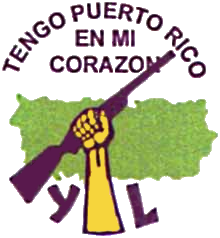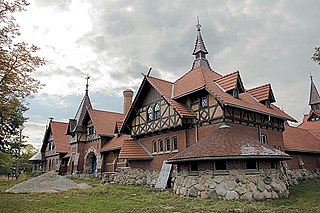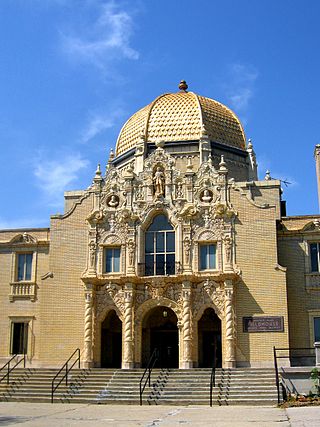Related Research Articles

Humboldt Park, one of 77 designated community areas, is on the West Side of Chicago, Illinois. The Humboldt Park neighborhood is known for its dynamic social and ethnic demographic change over the years. The Puerto Rican community has identified strongly with the area since the 1970s. Humboldt Park is also the name of the Chicago Park District's historic 207-acre (0.8 km2) park or public garden adjacent to the community area.

The Young Lords was a Chicago-based street gang that became a civil rights and human rights organization. The group, most active in the late 1960s and 1970s, aimed to fight for neighborhood empowerment and self-determination for Puerto Rico, Latino, and colonized people. Tactics used by the Young Lords include mass education, canvassing, community programs, occupations, and direct confrontation. The Young Lords became targets of the United States FBI's COINTELPRO program.

Parks in Chicago include open spaces and facilities, developed and managed by the Chicago Park District. The City of Chicago devotes 8.5% of its total land acreage to parkland, which ranked it 13th among high-density population cities in the United States in 2012. Since the 1830s, the official motto of Chicago has been Urbs in horto, Latin for "City in a garden" for its commitment to parkland. In addition to serving residents, a number of these parks also double as tourist destinations, most notably Lincoln Park, Chicago's largest park, visited by over 20 million people each year, is one of the most visited parks in the United States. Notable architects, artists and landscape architects have contributed to the 570 parks, including Daniel Burnham, Frederick Law Olmsted, Jens Jensen, Dwight Perkins, Frank Gehry, and Lorado Taft.

West Town, northwest of the Loop on Chicago's West Side, is one of the city's officially designated community areas. Much of this area was historically part of Polish Downtown, along Western Avenue, which was then the city's western boundary. West Town was a collection of several distinct neighborhoods and the most populous community area until it was surpassed by Near West Side in the 1960s. The boundaries of the community area are the Chicago River to the east, the Union Pacific railroad tracks to the south, the former railroad tracks on Bloomingdale Avenue to the North, and an irregular western border to the west that includes the grand city park called Humboldt Park. Humboldt Park is also the name of the community area to West Town's west, Logan Square is to the north, Near North Side to the east, and Near West Side to the south. The collection of neighborhoods in West Town along with the neighborhoods of Bucktown and the eastern portion of Logan Square have been referred to by some media as the "Near Northwest Side".

Ariel Reboyras is alderman of the 30th ward of the City of Chicago; he was first elected in 2003. He was previously a deputy commissioner in the general service department.

Division Street is a major east-west street in Chicago, Illinois, located at 1200 North. Division Street begins in the Gold Coast neighborhood near Lake Shore Drive, passes through Polonia Triangle at Milwaukee Avenue into Wicker Park and continues to Chicago's city limits and into the city's western suburbs. Once known as "Polish Broadway" during the heyday of Polish Downtown, Division Street was the favorite street of author Nelson Algren. A fountain dedicated in his name was installed in what had been the area that figured as the inspiration for much of his work.

The Chicago Park District is one of the oldest and the largest park districts in the United States. As of 2016, there are over 600 parks included in the Chicago Park District as well as 27 beaches, 10 boat docking harbors, two botanic conservatories, a zoo, 11 museums, and one stadium. The Chicago Park District also has more than over 230 field houses, 78 public pools, and dozens of sports and recreational facilities, with year-round programming. It also owns and operates the lakefront stadium, Soldier Field, which the Chicago Bears and Chicago Fire FC lease. The district is an independent taxing authority as defined by Illinois State Statute and is considered a separate agency of the City of Chicago. The district's headquarters are located in the Brighton Park neighborhood on the West Side of Chicago.
The Division Street riots were episodes of rioting and civil unrest in Chicago which started on June 12 and continued through June 14, 1966. These riots are remembered as a turning point in Puerto Rican civic involvement in Chicago. This was the first riot in the United States attributed to Puerto Ricans.

Paseo Boricua is a section of Division Street in the Humboldt Park community of the West Side of Chicago, Illinois.

Humboldt Park is a 207-acre (84 ha) park located at 1400 North Sacramento Avenue in West Town, on the West Side of Chicago, Illinois. To its west is the neighborhood named after it, also called Humboldt Park. It opened in 1877, and is one of the largest parks on the West Side. The park's designers include William Le Baron Jenney, and Jens Jensen.
Chicago High School for the Arts (ChiArts) is a public four–year college preparatory visual and performing arts high school located in the West Town community area, in Chicago, Illinois, United States. Operated by the Chicago Public Schools district, The school opened for the 2009–10 school year.

Puerto Ricans in Chicago are individuals residing in Chicago with ancestral ties to the island of Puerto Rico. Over more than seventy years, they have made significant contributions to the economic, social, and cultural fabric of the city.
José "Cha Cha" Jiménez is a political activist and the founder of the Young Lords Organization, a Chicago-based street gang that became a civil and human rights organization. Started in September 23, 1968, it was most active in the late 1960s and 1970s.
The Spanish Cobras is a primarily Latino street gang, present in multiple states throughout the Midwestern United States, with a strong presence on the north and west sides of Chicago, Illinois.
Dr. Pedro Albizu Campos Puerto Rican High School (PACHS) is an alternative high school located in the Humboldt Park neighborhood on the Paseo Boricua in Chicago, Illinois, United States. It is named for Puerto Rican nationalist Pedro Albizu Campos, and was founded in 1972 as La Escuelita Puertorriqueña, originally in the basement of a Chicago church. The school is NALSAS accredited, a founding member of the Alternative Schools Network, and a campus of the Youth Connection Charter School in Chicago. PACHS celebrated its 50th anniversary in October 2022.

The National Museum of Puerto Rican Arts and Culture is a museum in Chicago dedicated to interpreting the arts and culture of the Puerto Rican people and of the Puerto Ricans in Chicago. Founded in 2001, it is housed in the historic landmark Humboldt Park stables and receptory, near the Paseo Boricua.

The West Side is one of the three major sections of the city of Chicago, Illinois, United States. It is joined by the North and South Sides. The West Side contains communities that are of historical and cultural importance to the history and development of Chicago. On the flag of Chicago, the West Side is represented by the central white stripe.
The Humboldt Park riot was the second major conflict between Puerto Ricans in Chicago and the Chicago Police Department. The riot began on June 4, 1977, and lasted a day and a half. Following the shooting deaths of two Puerto Rican men, locals battled Chicago police officers in Humboldt Park and in the streets surrounding. The riot led the community to hold the Division Street Puerto Rican Day Parade, which started in 1978.
UrbanTheater Company (UTC) was founded in the Chicago neighborhood of Humboldt Park in 2005. The Humboldt Park and Puerto Rican communities are at the core of all of UrbanTheater Company's work, as evidenced by a variety of outreach measures to engage with the surrounding neighborhood. Their mission statement reads: "UTC is committed to the creation and exploration of urban-inspired works that convey, illuminate and empathize with the human experience".
The Chicago neighborhood of Humboldt Park is the founding grounds for several major gangs, including the Latin Kings, Simon City Royals, and Maniac Latin Disciples, among a number of other gangs with active chapters in the area as of 2023. With its roots dating back to the 1950s, the continuous presence and activity of gangs around the neighborhood has caused it to be a frequent subject of law enforcement, media, and residents over the years.
References
- ↑ "Puerto Rican Arts Alliance celebrates 20 years". ABC7 Chicago. September 21, 2018.
- 1 2 "About PRAA". www.praachicago.org. Archived from the original on 2011-11-18.